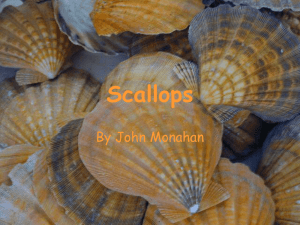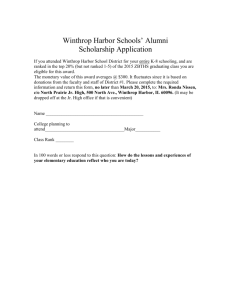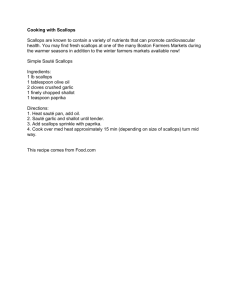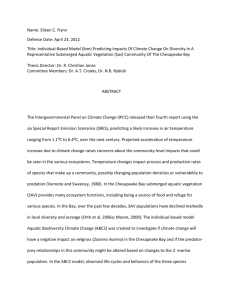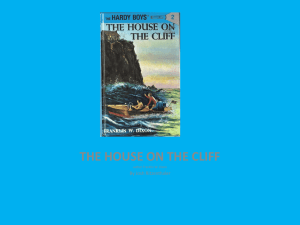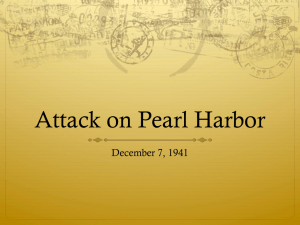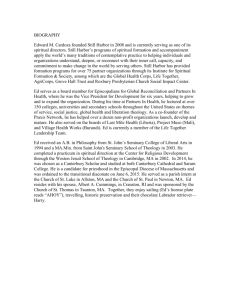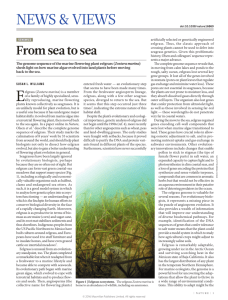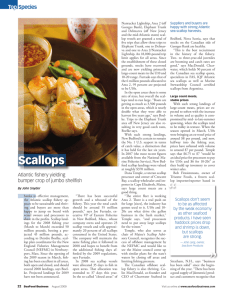A Feeling For the Organism, Val Hall & Creature Encounters, Jim
advertisement
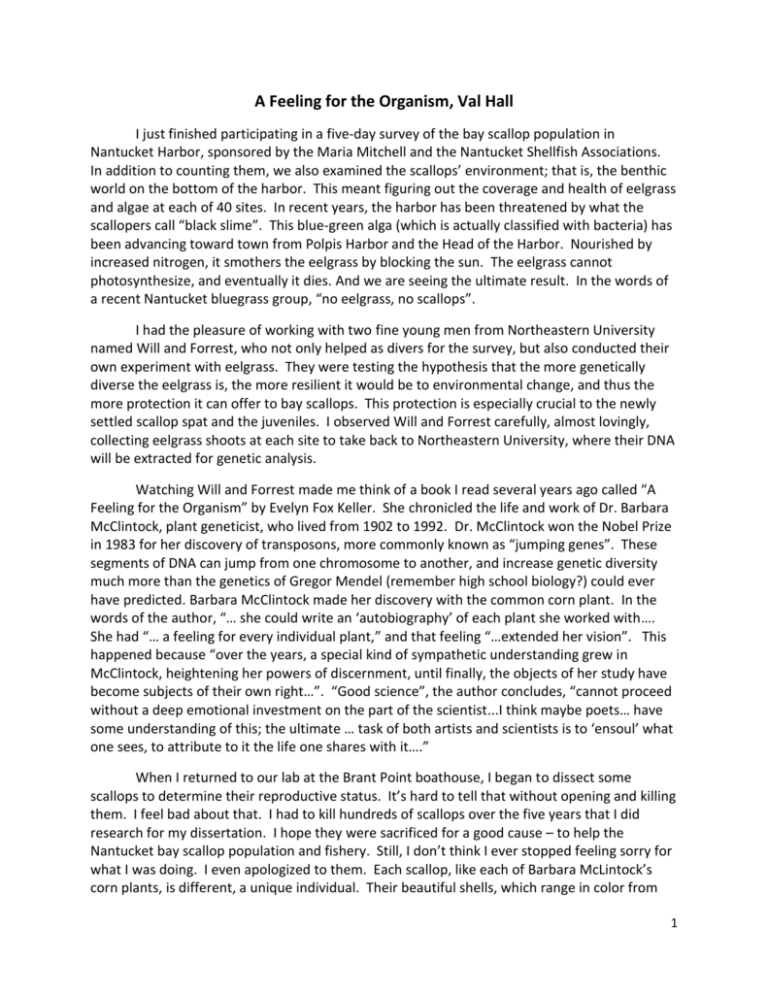
A Feeling for the Organism, Val Hall I just finished participating in a five-day survey of the bay scallop population in Nantucket Harbor, sponsored by the Maria Mitchell and the Nantucket Shellfish Associations. In addition to counting them, we also examined the scallops’ environment; that is, the benthic world on the bottom of the harbor. This meant figuring out the coverage and health of eelgrass and algae at each of 40 sites. In recent years, the harbor has been threatened by what the scallopers call “black slime”. This blue-green alga (which is actually classified with bacteria) has been advancing toward town from Polpis Harbor and the Head of the Harbor. Nourished by increased nitrogen, it smothers the eelgrass by blocking the sun. The eelgrass cannot photosynthesize, and eventually it dies. And we are seeing the ultimate result. In the words of a recent Nantucket bluegrass group, “no eelgrass, no scallops”. I had the pleasure of working with two fine young men from Northeastern University named Will and Forrest, who not only helped as divers for the survey, but also conducted their own experiment with eelgrass. They were testing the hypothesis that the more genetically diverse the eelgrass is, the more resilient it would be to environmental change, and thus the more protection it can offer to bay scallops. This protection is especially crucial to the newly settled scallop spat and the juveniles. I observed Will and Forrest carefully, almost lovingly, collecting eelgrass shoots at each site to take back to Northeastern University, where their DNA will be extracted for genetic analysis. Watching Will and Forrest made me think of a book I read several years ago called “A Feeling for the Organism” by Evelyn Fox Keller. She chronicled the life and work of Dr. Barbara McClintock, plant geneticist, who lived from 1902 to 1992. Dr. McClintock won the Nobel Prize in 1983 for her discovery of transposons, more commonly known as “jumping genes”. These segments of DNA can jump from one chromosome to another, and increase genetic diversity much more than the genetics of Gregor Mendel (remember high school biology?) could ever have predicted. Barbara McClintock made her discovery with the common corn plant. In the words of the author, “… she could write an ‘autobiography’ of each plant she worked with…. She had “… a feeling for every individual plant,” and that feeling “…extended her vision”. This happened because “over the years, a special kind of sympathetic understanding grew in McClintock, heightening her powers of discernment, until finally, the objects of her study have become subjects of their own right…”. “Good science”, the author concludes, “cannot proceed without a deep emotional investment on the part of the scientist...I think maybe poets… have some understanding of this; the ultimate … task of both artists and scientists is to ‘ensoul’ what one sees, to attribute to it the life one shares with it….” When I returned to our lab at the Brant Point boathouse, I began to dissect some scallops to determine their reproductive status. It’s hard to tell that without opening and killing them. I feel bad about that. I had to kill hundreds of scallops over the five years that I did research for my dissertation. I hope they were sacrificed for a good cause – to help the Nantucket bay scallop population and fishery. Still, I don’t think I ever stopped feeling sorry for what I was doing. I even apologized to them. Each scallop, like each of Barbara McLintock’s corn plants, is different, a unique individual. Their beautiful shells, which range in color from 1 white to yellow to orange, then on to brown and black, both mottled, stippled and striped. Their incredible blue eyes. The complexity of their anatomy and physiology, yet all packaged into what appears at first glance to be a simple animal. Yes, I love scallops. I have been fascinated by them since I first went to Woods Hole for a summer work-study job at the Marine Biological Lab at the tender age of 19. Scallops were the topic of both my master’s and doctoral research. The more I study them, the more I realize I don’t know. Michael West, astronomer at the Maria Mitchell Association, writes a wonderful column for the Inquirer and Mirror. Last week it was entitled “What can we learn from geckos?” In it, Dr. West bemoaned the deaths of countless animals sent into space for what seemed often to be trivial reasons, from Laika, the Russian space dog to gerbils and mice, and most recently five geckos that died in an experiment designed to see if they could procreate in space. [He doesn’t mention any of the innumerable invertebrates who also ‘gave their lives’ ]. He quotes Charles Darwin, who said that “the most notable attribute of man is our capacity to love all living creatures”. Dr. West goes on to say “If we humans believe we have the right to be treated compassionately by any aliens that we might someday encounter … then surely we have a moral obligation to treat other creatures the same way we would want to be treated”. The 7th principle of Unitarian Universalism is “Respect for the interdependent web of all existence of which we are a part.” To me that includes a “feeling for the organism”: its way of life, its environment, its role in both the natural and human communities. We all need to feel this, whether or not we are scientists. Michael West concludes “Someday, far from now, when humans travel among the stars, perhaps the most precious gift they can bring will be our humanity.” A few years ago, the yacht club was giving away a fourteen-foot instructional sailboat, free for the taking, and I was the lucky recipient. Each year, early in June, I launch the boat in Polpis harbor, where I keep it moored through the summer months. I’ve found there is much to like about sailing. There’s challenges—weaving your way through the little tidal creek that leads from Polpis out into the main harbor can take work, especially when the tide is rushing against you, and the wind is blasting from an unfavorable angle. There’s moments of excitement— leaning back over the gunwale in a strong wind to keep the boat from heeling over too far, getting drenched by the cold, bracing spray. There are also gentle moments. A breath of northeast wind can send my little boat skimming surprisingly fast across the glassy waters and creates, for me, the best and most real form of meditation. And there’s the beauty of Polpis harbor—pristine clear waters, blue skies, clouds of all shapes and descriptions, and lovely cadenced banks of sand and vegetation. But it’s what the boat allows me to see and hear and smell and touch that is most precious to me—the creature encounters. 2 Creature Encounters, Jim Sulzer My first year sailing, I landed on a spot on Coatue and went for a walk up a little tidal valley—dry except at high tide—and found a puzzling sight. There was a bank—you might almost say a herd—of plump little green cactus plants. What was a colony of cacti doing on Coatue? I wondered. Later I learned that Coatue is the northern-most spot in North America where these plants—the prickly pear cactus—grow wild. A week later, in an even more surprising development, each little cactus put forth a gorgeous flower—a huge, yellow and orange, full-petaled flower, each one almost as large as the cactus that created it. The flowers lasted only a few days, making up with their intensity and beauty what they lacked in longevity. Bees fondled them lovingly and reverently; small bugs traipsed innocently across their volcanic expanses. Shriveling up after a few days, the flowers left behind a green, knobbed fruit. Sometimes I picture the cacti in winter—dried up, dull and colorless, beaten down by rain and sleet and snow in our harsh northern climate—holding on somehow as they wait for those glorious, warm days of early July to draw forth their annual offering to the sun. Each year, one of my most meaningful journeys in my little blue boat is to make a pilgrimage to this secret spot and take pictures of the prickly pear cactus plants in full bloom. Throughout the summer, from my boat, I am blessed with the sight of all kinds of birds. My favorites are the little oystercatchers, with their striking black and white markings, their long red beaks, their orange feet. In a way they seem like nature’s clowns—dashing around at great speeds on foot or in the air, keening with their distinctive chirps, traveling about in small, companionable flocks. Apparently oystercatchers come in two different varieties, the snippers and the pounders. They are genetically identical and differ only by training. Snippers open shellfish by reaching inside with their long beaks and snipping the muscle. Pounders pick up the shellfish and pound it open on a hard surface. An oystercatcher will be one or the other, depending upon which family it is born into. It seems that humans are not the only life form that has different cultures. They are humanlike in other ways, too. Once as I explored the backwaters of Coatue an oystercatcher started divebombing me and then—apparently changing tactics—it landed on the sand and walked along in front of me, limping, holding one wing to the side. I guessed at once what it was about, and secretly praised it for its courage and smarts. Good little mother—as fierce in her love as a human mother—she was pretending to be wounded and a prey, in order to lure me away from the nest and her little ones. Egrets are another extraordinary bird. From a distance, standing in the marshes, they look like long, white question marks. When hunting they step about on long, stalk-like legs with the grace of ballet dancers, bending to plunge their long, pointed beaks into the water. In flight, they curve back their long necks in stork-like contortions and make a strange, primitive, guttural squawk that sounds, I imagine, not unlike the dinosaurs that ranged over the swamps of yesteryear. An osprey soars overhead, carrying a large fish in its sharp claws—holding the fish pointing perfectly straightforward. They aren’t always so lucky. Last week I saw an osprey circle 3 low over the water, gather itself for a dive, and transform its body into a slender arrow just before it smacked into the water. Three times it dove, and three times it came up empty. A predator’s life is harder than we imagine. There are many more birds—ducks laboring in solemn, sober flight, geese honking and winging overhead in swift V’s, their feathers creaking with the strain of carrying all that weight, gulls circling lazily. Each bird seems to have its own agenda, its own thoughts, its own form of consciousness. The sea creatures are equally compelling. Toward the end of summer, as the winds shift, it becomes easier to sail up to Coskata and the long tidal creek that connects the head of the harbor to the pond. Small fish leap like crazy in the shallows of the creek, flipping their little white bodies into the sunlight, full of energy and elation. Fiddler crabs march about like armies in a tiny Tolkien landscape; at times they are so densely packed, the beach itself seems to be moving. Hiding in the sea grass are the largest blue-clawed crabs I’ve ever seen, proud and separate as cats, observing you carefully as you approach, spreading their claws, edging to the side on strong, bent legs. They are figuring you out, probably wondering if you are food or danger; and though they may choose to retreat, they never yield their dignity to you. One of the most miraculous sights I’ve seen came one evening late in summer while walking along the shore of Madaket harbor. Lying at water’s edge at low tide was a gathering of eight or ten channeled whelk (which are sometimes mistakenly called conch). Attached to each whelk was a long, vertebra-like, spiral shaped structure—about a foot long. It’s something we’ve all seen, perhaps during winter walks—washed up on shore, desiccated. They are seed casings—if you pull them apart, you can find tiny, perfectly formed little shells. I’d always wondered how these casings came into the world, and never imagined that one day I’d come upon the actual birthing process, the mother whelks lying in their little nursery, still attached to the egg sacs that they were about to release to carry their life form forward in time. It was wondrous sight: as strange as a squadron of alien spaceships downloading a life form. At its heart, all life—even our own—is an alien and unfathomable gift. And so goes my time on the water. The end of summer comes all too soon each year, bringing my sailing to an end—but hey, scalloping begins on October 1, offering new adventures and encounters in our fragile, miraculous world of sea and sand. 4
